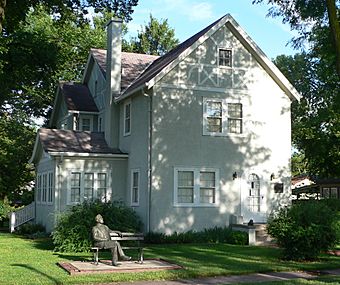George W. Norris House facts for kids
|
George W. Norris House
|
|

George Norris House, seen from the southeast. At lower left is a seated statue of Norris.
|
|
| Location | 706 Norris Ave., McCook, Nebraska |
|---|---|
| Built | 1899 |
| NRHP reference No. | 67000006 |
Quick facts for kids Significant dates |
|
| Added to NRHP | May 28, 1967 |
| Designated NHL | May 28, 1967 |
The Senator George William Norris House is a special old house in McCook, Nebraska. It is now a historic house museum, which means people can visit it to learn about the past. This house was bought in 1899 by George W. Norris. He was a very important politician from Nebraska who lived from 1862 to 1944.
George Norris helped create big programs like the New Deal in the 1930s. He also supported the Rural Electrification Act. These programs helped bring electricity to many parts of the country. The house was named a National Historic Landmark in 1967. His wife later gave the house to the Nebraska State Historical Society in 1968.
About the Norris House
The Norris House is located north of downtown McCook. It stands on the west side of Norris Avenue. Across the street is Norris Park, a small public park. The house is two and a half stories tall. It is made of wood with a stucco outside. The roof has a pointed shape called a gable.
The house is mostly rectangular. It has smaller two-story sections on its sides. There is also a sunny room on the south side. The ends of the gabled roof are also covered in stucco. They have cool decorative designs. The main front door is in a rounded archway. Inside, the house still has many items that belonged to the Norris family.
Who Was George Norris?
George Norris bought this house in 1899. This was early in his political career. He served five terms in the United States House of Representatives. He also served five terms as a United States senator. He was known for supporting progressive ideas. These were new ways of thinking in the Republican Party.
Norris's Big Ideas and Projects
George Norris was a strong supporter of several important projects. He helped create the Tennessee Valley Authority (TVA). This project built dams and power plants. It brought electricity and flood control to a large region. One of the first dams built for the TVA was even named Norris Dam after him.
He was also a major supporter of the Rural Electrification Act. This law was very important. Before this act, many farms and small towns did not have electricity. The act helped bring power lines to these areas. This changed life for millions of Americans. It allowed them to have lights, radios, and modern appliances.
Norris passed away in 1944. His wife later gave their home to the state historical society in 1968. This made sure that people could continue to learn about his life and work.
See Also



